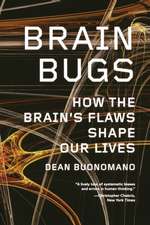Neurobiology of "Umwelt": How Living Beings Perceive the World: Research and Perspectives in Neurosciences
Editat de Alain Berthozen Limba Engleză Hardback – 12 noi 2008
| Toate formatele și edițiile | Preț | Express |
|---|---|---|
| Paperback (1) | 774.63 lei 38-44 zile | |
| Springer Berlin, Heidelberg – 30 noi 2010 | 774.63 lei 38-44 zile | |
| Hardback (1) | 917.09 lei 43-57 zile | |
| Springer Berlin, Heidelberg – 12 noi 2008 | 917.09 lei 43-57 zile |
Din seria Research and Perspectives in Neurosciences
- 18%
 Preț: 917.87 lei
Preț: 917.87 lei - 18%
 Preț: 911.88 lei
Preț: 911.88 lei - 18%
 Preț: 914.66 lei
Preț: 914.66 lei - 18%
 Preț: 1183.22 lei
Preț: 1183.22 lei - 18%
 Preț: 918.78 lei
Preț: 918.78 lei - 5%
 Preț: 1369.20 lei
Preț: 1369.20 lei - 18%
 Preț: 1180.79 lei
Preț: 1180.79 lei - 5%
 Preț: 691.34 lei
Preț: 691.34 lei - 18%
 Preț: 917.27 lei
Preț: 917.27 lei - 18%
 Preț: 910.07 lei
Preț: 910.07 lei - 15%
 Preț: 620.61 lei
Preț: 620.61 lei - 18%
 Preț: 918.48 lei
Preț: 918.48 lei - 15%
 Preț: 618.40 lei
Preț: 618.40 lei - 15%
 Preț: 618.40 lei
Preț: 618.40 lei - 18%
 Preț: 861.17 lei
Preț: 861.17 lei - 15%
 Preț: 617.28 lei
Preț: 617.28 lei - 15%
 Preț: 618.08 lei
Preț: 618.08 lei - 15%
 Preț: 617.46 lei
Preț: 617.46 lei - 15%
 Preț: 617.90 lei
Preț: 617.90 lei - 24%
 Preț: 734.64 lei
Preț: 734.64 lei -
 Preț: 410.28 lei
Preț: 410.28 lei - 5%
 Preț: 502.39 lei
Preț: 502.39 lei - 18%
 Preț: 910.50 lei
Preț: 910.50 lei
Preț: 917.09 lei
Preț vechi: 1118.41 lei
-18% Nou
Puncte Express: 1376
Preț estimativ în valută:
175.53€ • 182.95$ • 146.12£
175.53€ • 182.95$ • 146.12£
Carte tipărită la comandă
Livrare economică 06-20 ianuarie 25
Preluare comenzi: 021 569.72.76
Specificații
ISBN-13: 9783540858966
ISBN-10: 3540858962
Pagini: 172
Ilustrații: XII, 158 p. 22 illus., 15 illus. in color.
Dimensiuni: 155 x 235 x 15 mm
Greutate: 0.41 kg
Ediția:2009
Editura: Springer Berlin, Heidelberg
Colecția Springer
Seria Research and Perspectives in Neurosciences
Locul publicării:Berlin, Heidelberg, Germany
ISBN-10: 3540858962
Pagini: 172
Ilustrații: XII, 158 p. 22 illus., 15 illus. in color.
Dimensiuni: 155 x 235 x 15 mm
Greutate: 0.41 kg
Ediția:2009
Editura: Springer Berlin, Heidelberg
Colecția Springer
Seria Research and Perspectives in Neurosciences
Locul publicării:Berlin, Heidelberg, Germany
Public țintă
ResearchCuprins
Anthropological Physiology: von Uexküll, Portmann, Buytendijk.- Essentialist Reasoning about the Biological World.- The Human Brain “Projects” upon the World, Simplifying Principles and Rules for Perception.- Umwelt: A Psychomotor Functional Event.- The Brain's View of the World Depends on What it has to Know.- The Biology of Variations in Mammalian Color Vision.- The Evolution of Social Categories.- What is the Effect of Affect on Bonobo and Chimpanzee Problem Solving?.- Dogs (Canis familiaris) are Adapted to Receive Human Communication.- What Do Jays Know About Other Minds and Other Times?.- Blind as a Bat? The Sensory Basis of Orientation and Navigation at Night.- Point, Line and Counterpoint: From Environment to Fluid Space.
Textul de pe ultima copertă
At the beginning of the 20th century, German biologist Jakob von Uexküll created the concept of "Umwelt" to denote the environment as experienced by a subject. This concept of environment differs from the idea of passive surroundings and is defined not just by physical surroundings, but is rather a "subjective universe", a space weighted with meaning. Based on this perspective, a living organism, no matter how basic (such as the tick studied by von Uexküll), created its own universe when it interacts with the world and as this same time the organism reshapes it.
Today, neuroscience provides a new way to look at the brain’s capability to create a representation of the world. At the same time behavioural specialists are demonstrating that animals have a richer mental universe than previously known. Philosophical reflection thus finds itself with more experimental and objective data as well. Nearly a century after the publication of von Uexküll’s founding work ( "Umwelt und Innenwelt der Tiere" was published in 1909), neurobiologists, psychologists, sociologists, anthropologists, ethologists, and philosophers revisit his mail concept at the light of modern science
Today, neuroscience provides a new way to look at the brain’s capability to create a representation of the world. At the same time behavioural specialists are demonstrating that animals have a richer mental universe than previously known. Philosophical reflection thus finds itself with more experimental and objective data as well. Nearly a century after the publication of von Uexküll’s founding work ( "Umwelt und Innenwelt der Tiere" was published in 1909), neurobiologists, psychologists, sociologists, anthropologists, ethologists, and philosophers revisit his mail concept at the light of modern science
Caracteristici
Includes supplementary material: sn.pub/extras













